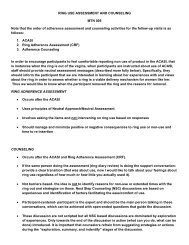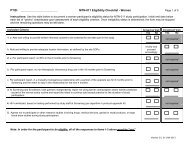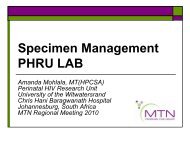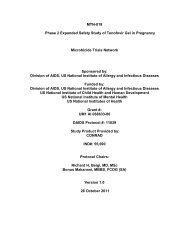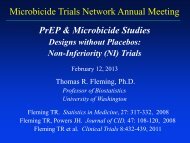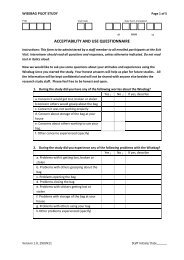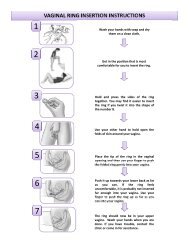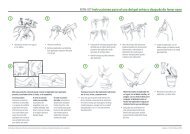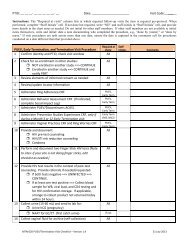14. LABORATORY ISSUES ............................................................
14. LABORATORY ISSUES ............................................................
14. LABORATORY ISSUES ............................................................
You also want an ePaper? Increase the reach of your titles
YUMPU automatically turns print PDFs into web optimized ePapers that Google loves.
<strong>14.</strong> <strong>LABORATORY</strong> <strong>ISSUES</strong> ........................................................................................ 1<br />
<strong>14.</strong>1 MTN Laboratory Program................................................................................... 2<br />
<strong>14.</strong>1.1 MTN Laboratory Quality Assessment Policy ...................................................... 2<br />
<strong>14.</strong>1.2 MTN Laboratory Quality Control Policy .............................................................. 2<br />
<strong>14.</strong>2 MTN Laboratory Quality Assessment and Quality Control Program ............. 3<br />
<strong>14.</strong>3 CRS Laboratory Performance Assessment ..................................................... 3<br />
<strong>14.</strong>3.1 Non-U.S. CRS Laboratories............................................................................... 3<br />
<strong>14.</strong>3.2 Non-affiliated External Laboratories Outside the U.S. ....................................... 3<br />
<strong>14.</strong>3.2.1 Requirements for Sites Using Non-Affiliated External Laboratories ................. 4<br />
<strong>14.</strong>3.2.2 Responsibilities of MTN Sites for QA of Non-Affiliated External Laboratories .. 4<br />
<strong>14.</strong>3.3 Proficiency Testing ............................................................................................ 4<br />
<strong>14.</strong>3.4 U.S. CRS Laboratory Certification ..................................................................... 5<br />
<strong>14.</strong>4 MTN Network Laboratory Oversight of CRS Laboratories .............................. 5<br />
<strong>14.</strong>5 Laboratory Monitoring by the Clinical Safety Monitoring Group ................... 5<br />
<strong>14.</strong>6 Specimen Handling and Processing ................................................................. 6<br />
<strong>14.</strong>6.1 Lab Specimen Labels Provided by SDMC ......................................................... 6<br />
<strong>14.</strong>6.2 Laboratory Data Management System .............................................................. 6<br />
<strong>14.</strong>6.3 Specimen Shipping ............................................................................................ 6<br />
<strong>14.</strong>7 Testing of Stored Specimens Policy ................................................................. 8<br />
<strong>14.</strong>8 Destruction of MTN Samples ............................................................................. 9<br />
<strong>14.</strong>9 Laboratory-Related Site-Specific Protocol-Activation Requirements .......... 10<br />
<strong>14.</strong>10 Validation of HIV Antibody-Testing Algorithms ........................................... 11<br />
<strong>14.</strong>11 Centralized Testing ......................................................................................... 12<br />
<strong>14.</strong>12 Laboratory Safety ........................................................................................... 13<br />
<strong>14.</strong>13 Document Standards ...................................................................................... 13<br />
<strong>14.</strong>14 Training and Competency .............................................................................. 13<br />
<strong>14.</strong>15 Method Validation ........................................................................................... 13<br />
<strong>14.</strong>16 Quality Assurance Testing............................................................................. 13<br />
<strong>14.</strong>17 Endpoint Adjudication Committee ................................................................ 14<br />
<strong>14.</strong> <strong>LABORATORY</strong> <strong>ISSUES</strong><br />
All Microbicide Trials Network (MTN) study sites are required to adhere to standards of Good<br />
Clinical Laboratory Practice (GCLP), the HIV Prevention Trials Network (HPTN)-MTN<br />
Laboratory Manual, and local Standard Operating Procedures (SOPs) for proper collection,<br />
processing, labeling, transportation, and storage of laboratory specimens. In most cases,<br />
laboratories with Clinical Laboratory Improvement Amendments (CLIA) certification may submit<br />
this as documentation of GCLP compliance.<br />
Network Web Links:<br />
• Microbicides Trials Network: http://www.mtnstopshiv.org<br />
• HIV Prevention Trials Network: http://www.hptn.org<br />
The HPTN/MTN Laboratory Manual, a standard set of procedures developed by the HPTN<br />
Network Laboratory (NL) in conjunction with the MTN NL, outlines specific requirements for<br />
laboratory quality assessment (QA) procedures and quality control (QC) activities. This manual<br />
May 2012 1
includes guidelines for specimen collection, management, processing, storage, transportation,<br />
tracking and laboratory QC, including handling reagents and conducting assays. References for<br />
applicable U.S. federal and international regulations are provided. This SOP is made available<br />
to each MTN performance site. In addition to this network-level SOP, the Study Specific<br />
Procedures (SSP) Manual developed for each protocol contains a section on laboratory<br />
procedures with detailed instructions for the specific protocol.<br />
<strong>14.</strong>1 MTN Laboratory Program<br />
<strong>14.</strong>1.1 MTN Laboratory Quality Assessment Policy<br />
The MTN NL has developed and implemented a generic network laboratory QA policy that is the<br />
basis for a range of QA activities carried out by the MTN NL and the site. This laboratory QA<br />
policy applies to all MTN laboratories and is designed to monitor, evaluate, and improve the<br />
quality of laboratory data; ensure the reliability of test data; and evaluate the competency of the<br />
site laboratory staff. The Clinical Research Site (CRS) is responsible for implementing the QA<br />
policy at the CRS laboratories.<br />
The objectives of the MTN laboratory QA policy (and related programs) are to:<br />
• ensure that QA activities are comprehensive and coordinated and that appropriate<br />
information is reviewed and reported<br />
• establish, maintain, support, and document an ongoing QA program that includes effective<br />
and systematic mechanisms for monitoring, collecting, and evaluating information about<br />
important aspects of laboratory data to identify opportunities for improving data analysis and<br />
participant care<br />
• assist in improving care and identifying problems through continuous monitoring and<br />
focusing on identification, assessment, correction, and follow-up of problems that affect data<br />
analysis and participant care<br />
• implement corrective action when problems or opportunities are identified<br />
• follow up on identified problems to ensure improvement and resolution<br />
The complete QA policy, Laboratory Quality Assurance and Quality Assessment Policy, is<br />
attached to this manual as Appendix IV. See Appendix V for the QA policy specific to HIV<br />
testing.<br />
<strong>14.</strong>1.2 MTN Laboratory Quality Control Policy<br />
CRS laboratory QC activities are an integral part of the laboratory QA program. The CRS QC<br />
program is divided into the following main areas of focus:<br />
• internal QC (testing of known materials)<br />
• parallel testing—validation of new controls and reagent lots<br />
• blinded or split-sample testing<br />
• proficiency (that is, external) testing programs<br />
• QC monitoring—corrective action logs<br />
• QA program feedback<br />
• Preventative maintenance program<br />
May 2012 2
Further guidance for developing a site QC program that incorporates these components is<br />
contained in Appendix VI.<br />
<strong>14.</strong>2 MTN Laboratory Quality Assessment and Quality Control Program<br />
Each CRS involved in MTN research is expected to develop a site-specific laboratory QA/QC<br />
plan to expand on the generic Appendix IV: Laboratory Quality Assurance and Quality<br />
Assessment Policy, and Appendix VI: Laboratory Quality Control Policy instituted by the MTN<br />
NL. The MTN laboratory QA policy, generic SOPs, and the MTN QC policy, all of which provide<br />
guidance on developing a site-specific laboratory QA/QC plan, are included in the HPTN/MTN<br />
Laboratory Manual, which is available to each site and through the MTN website<br />
(http://www.mtnstopshiv.org/sites/default/files/attachments/HPTN-<br />
MTNLABMANUALVersion1.0.pdf). The site-specific QA/QC plan is designed to ensure<br />
accurate, timely, and reliable test results by providing routine monitoring of the overall laboratory<br />
operation.<br />
<strong>14.</strong>3 CRS Laboratory Performance Assessment<br />
<strong>14.</strong>3.1 Non-U.S. CRS Laboratories<br />
The MTN NL has arranged for non-U.S. local laboratories that participate in MTN research to<br />
receive proficiency panels from the American Society of Clinical Pathologists (ASCP), the<br />
College of American Pathologists (CAP), the United Kingdom National External Quality<br />
Assessment Service (UK NEQAS), as well as other approved proficiency providers. The panels<br />
are sent to the sites based on the assays performed for the specific MTN trials in which the site<br />
is participating. Each year, via the Patient Safety Monitoring and International Laboratory<br />
Evaluation (pSMILE) group, the MTN NL re-enrolls sites based on the assays that are/will be<br />
done at that specific site. The MTN NL follows the results and communicates directly with the<br />
sites regarding any potential issues or problems with the results, and works with the sites to<br />
identify corrective actions as needed. This oversight is achieved as part of a cross-network<br />
collaboration with other U.S. National Institute of Allergy and Infectious Diseases (NIAID)<br />
Division of AIDS (DAIDS) HIV/AIDS clinical trials networks and pSMILE as part of the Primary<br />
Network Laboratory (PNL) system. In addition, each laboratory undergoes an assessment by<br />
the Clinical Site Monitoring Group (CSMG) and receives results generally through the DAIDS,<br />
including recommendations for and assistance on addressing existing or potential problems.<br />
The MTN NL reports annually on-site performance in the proficiency-testing program and<br />
shipping quality to the MTN Network Evaluation Committee (NEC).<br />
<strong>14.</strong>3.2 Non-affiliated External Laboratories Outside the U.S.<br />
Non-affiliated laboratories are laboratories (often commercial) that are contracted and paid by<br />
an MTN site to perform tests on specimens collected during an MTN study or to be used as part<br />
of a back-up plan (see Guidelines for Use of Back-Up Equipment and Back-up Laboratories for<br />
Safety Testing in DAIDS-Sponsored Clinical Trials,<br />
http://portal.hanc.info/lab/focusgroup/WorkgroupDocs/Forms/BackUp%20Plans.aspx).<br />
Although the use of non-affiliated laboratories is necessary sometimes, this practice is not<br />
encouraged, because oversight is frequently difficult to manage. The MTN NL has developed<br />
and implemented strategies to assess and monitor performance of non-affiliated laboratories<br />
that receive and process specimens from non-U.S. MTN sites.<br />
May 2012 3
<strong>14.</strong>3.2.1 Requirements for Sites Using Non-Affiliated External Laboratories<br />
The MTN NL has specific requirements for sites that send samples to such external nonaffiliated<br />
laboratories. Sites may periodically include blinded positive and negative specimens<br />
(controls) along with test specimens sent to these laboratories. This provides a basis for<br />
monitoring the performance of external non-affiliated laboratories, and assists those laboratories<br />
in identifying possible problems with their assay procedures. Site staff should consult the MTN<br />
NL Manager about which assays should be monitored, which control materials should be used,<br />
and the anticipated range of external laboratory results that are considered acceptable for a<br />
particular assay. When necessary, MTN NL staff will assist in obtaining the required control<br />
materials. Results are monitored as part of the proficiency panels submitted to UK NEQAS and<br />
CAP, as described above.<br />
The MTN NL staff may visit external non-affiliated laboratories that are (or will be) receiving and<br />
processing specimens collected during MTN studies. Early visits, prior to initiation of a specific<br />
study, will focus on a laboratory’s capability to perform required tests. When NL staff travel to<br />
MTN sites, they will also visit external laboratories when possible and document these visits.<br />
<strong>14.</strong>3.2.2 Responsibilities of MTN Sites for QA of Non-Affiliated External Laboratories<br />
MTN sites that contract with external laboratories for specimen testing must work with the NL<br />
and the external laboratories to ensure, as much as possible, the integrity of the results and<br />
handling of specimens. Each MTN study site that uses an external laboratory must:<br />
• consult with NL staff to determine which assays conducted at external laboratories will<br />
require inclusion of periodic controls, and which materials should be used as controls<br />
• consult with NL staff to determine the minimal frequency for including control samples in<br />
assays conducted at external laboratories<br />
• document incorporation of known controls into groups of samples submitted to external<br />
laboratories<br />
• collate results of assays done on these controls and fax information to NL monthly (or more<br />
often, if requested)<br />
• maintain archival records of all documentation of results for assays done on control samples<br />
• consult NL staff immediately in case of unacceptable results to determine a plan for<br />
assessing performance of the external laboratory in greater detail, and discuss possible<br />
plans for corrective action<br />
• submit QC records and Levy Jennings charts for laboratory-safety determinations to the<br />
MTN NL or HPTN NL (whichever is designated) on a monthly basis by fax, post, or email,<br />
unless other arrangements are approved<br />
<strong>14.</strong>3.3 Proficiency Testing<br />
Each site will be enrolled in proficiency testing as appropriate for the studies. Prior to study<br />
activation, the laboratory must pass one round of proficiency testing. When a site is participating<br />
in a protocol, the recommendations for proficiency testing results are as follows:<br />
• Any deficiency, regardless of the scoring, will require corrective action by the site laboratory.<br />
• A site laboratory’s failure to report to the pSMILE group that a panel has not been received<br />
may be considered unsatisfactory.<br />
May 2012 4
• If the results are not graded by the proficiency provider because the results were submitted<br />
late, pSMILE will make an effort to grade the results and document that the panel is<br />
considered late.<br />
• When a site laboratory receives unsatisfactory results on two panels in a row, or two out of<br />
three panels, the NL and pSMILE will provide instructions to the laboratory on what<br />
corrective action needs to be taken in addition to reporting the corrective action.<br />
• When a site laboratory receives unsatisfactory results on two panels in a row or two out of<br />
three, the laboratory’s back-up plan goes into effect and the laboratory cannot perform<br />
protocol testing for those particular analytes. The site laboratory, NL, DAIDS Clinical<br />
Laboratory Oversight Team Point of Contact (DCLOT POC), and pSMILE will confer on a<br />
corrective action plan that may include additional panel testing.<br />
• For the HIV viral load, HIV DNA, and CD4 proficiency panel results, the NL will follow the<br />
recommendations of the appropriate governing QA partner—pSMILE, Virology Quality<br />
Assurance (VQA), Immunology Quality Assurance (IQA), or UKNEQAS—and take<br />
appropriate action based on these recommendations.<br />
<strong>14.</strong>3.4 U.S. CRS Laboratory Certification<br />
Laboratories within the United States that participate in MTN research are required to have<br />
CLIA certification and to provide documentation of this certification to the NL. Recertification is<br />
required every two years. The CLIA certification may serve as proxy for certain documentation<br />
requirements of GCLP. The MTN may request to review GCLP documentation from U.S. CRS<br />
laboratories. Certain documentation (such as laboratory normal ranges and study-specific<br />
SOPs) will be required for study activation.<br />
<strong>14.</strong>4 MTN Network Laboratory Oversight of CRS Laboratories<br />
The NL staff may conduct periodic site visits to assess the implementation of laboratory QC<br />
procedures, including proper maintenance of laboratory testing equipment and appropriate use<br />
of reagents. The purpose and scope of the visit is discussed with site personnel prior to the visit.<br />
In addition, the NL may place a temporary laboratory technician/advisor on-site if the need is<br />
indicated. Whether on-site or centrally located, the NL staff work directly with the MTN site staff<br />
to address and resolve any QC or QA problems identified through proficiency testing or site<br />
visits, or by the site during study preparation or implementation.<br />
<strong>14.</strong>5 Laboratory Monitoring by the Clinical Safety Monitoring Group<br />
The DAIDS CSMG monitors periodically conduct a complete laboratory audit prior to or during<br />
the MTN study. The SDMC provides the CSMG monitors with site-specific laboratory<br />
information to enable them to conduct expected monitoring of specimen processing and storage<br />
of study-specific archived samples.<br />
Monitoring Web Links:<br />
• U.S. Food and Drug Administration (FDA): http://www.fda.gov<br />
• College of American Pathologists (CAP): http://www.cap.org<br />
• U.K. National External Quality Assessment Service: http://www.ukneqas.org.uk<br />
• Westat: http://www.westat.com<br />
May 2012 5
• Laboratory Data Management System (LDMS):<br />
https://www.fstrf.org/apps/cfmx/apps/ldms/index.html<br />
• HIV/AIDS Network Coordination (HANC): http://www.hanc.info<br />
• pSMILE: http://162.129.103.142/SMILE/<br />
<strong>14.</strong>6 Specimen Handling and Processing<br />
General requirements and procedures for specimen handling and processing are included in the<br />
HPTN/MTN Laboratory Manual. In addition, each laboratory is required to use the LDMS for<br />
collecting, testing, storing, and labeling certain biological samples designated for each study.<br />
<strong>14.</strong>6.1 Lab Specimen Labels Provided by SDMC<br />
The SDMC-provided labels for lab specimens include the Participant Identification Number<br />
(PTID) and a space to write the date and visit code for the visit at which it was collected. The<br />
labels are intended for use only on original specimen “containers” (such as vacutainers and<br />
slides). If a specimen is to be processed, then the LDMS labeling system will be used to<br />
generate other labels after the information has been entered into the LDMS.<br />
<strong>14.</strong>6.2 Laboratory Data Management System<br />
The Frontier Science and Technology Research Foundation (FSTRF) and the NL provide<br />
training and support to local laboratory staff in the use of LDMS. Each CRS laboratory is<br />
financially responsible for training the staff members. The CRS laboratory is responsible for<br />
maintaining its LDMS program, including hardware and software upgrades. The NL develops<br />
code sheets for each protocol to ensure that specimens are entered correctly into the system.<br />
Additional details are included in each SSP Manual.<br />
The SDMC offers pre-printed labels and specimen-tracking sheets for use by sites to facilitate<br />
entry of specimens into the LDMS database. For each study, the protocol and SSP Manual will<br />
indicate which specimens will be stored locally and which will be shipped to the NL for testing.<br />
The SSP Manual also will indicate, with instructions, which specimens must be entered into the<br />
LDMS.<br />
<strong>14.</strong>6.3 Specimen Shipping<br />
Specimens will be transported in accordance with International Air Transport Association (IATA)<br />
regulations and with U.S. federal, international, and local laws. This applies to transporting<br />
specimens on-site, to and from the clinic and the laboratory, and from the site to the NL. Study<br />
and laboratory personnel involved with packaging and transporting specimens must receive<br />
adequate and appropriate training to ensure compliance with guidelines and regulations.<br />
Documentation of training must be filed on-site and a copy sent to the NL.<br />
The IATA regulates the safe transportation of dangerous goods by air in accordance with its<br />
legal requirements. The IATA requires training and certification for those involved with shipping<br />
Class 6.2 infectious substances and diagnostic specimens. The IATA regulations define<br />
infectious substances, cultures and stocks, biologic products, and diagnostic specimens, and<br />
specify the requirements for handling and shipping each of them. Diagnostic specimens and<br />
infectious substances are further separated into risk groups based on the organism that is<br />
known or suspected to be present within the sample.<br />
May 2012 6
Definitions of key terms follow:<br />
Class 1: Explosives<br />
Class 2: Gases<br />
Class 3: Flammable Liquids<br />
Class 4: Flammable Solids<br />
Class 5: Oxidizers/Organic Peroxides<br />
Class 6: Toxic and Infectious Substances<br />
• Division 6.1—Toxic Substances<br />
o Guanidinium—chemical preservative<br />
• Division 6.2—Infectious Substances<br />
o Cat A Infectious Substances–Packing instructions 602<br />
This subsection refers to infectious substances that are shipped in a form that can lead<br />
to exposure and subsequent permanent disability or life-threatening or fatal diseases in<br />
humans or animals. Category A substances that affect humans are assigned to UN28<strong>14.</strong><br />
This includes viral isolates from cultures of HIV and Hepatitis B.<br />
o Cat B Biological Substances–Packing Instruction 650<br />
This subsection refers to any human or animal material including, but not limited to,<br />
excreta; secreta; blood and its components; tissue and tissue fluids; body parts being<br />
transported for research diagnosis, investigational activities, disease treatment or<br />
prevention; and/or any infectious substance that does not meet the criteria for Category<br />
A. For shipping purposes, these are considered to be Category B biological specimens<br />
and must be assigned to UN 3373. Note: Some countries do not recognize Category B<br />
substances, in which case, specimens must be shipped as Category A substances.<br />
o Exempt Human Specimens–Packing Instructions 650<br />
Exempt Human Specimens is a new category for low-risk items that have a slight<br />
possibility of being infectious. This category includes routine blood testing, such as in<br />
insurance screening and drug testing, dried blood spots, fecal hemocults, and screened<br />
blood products. Exempt specimens should be packed as Category B samples using<br />
diagnostic shipping (PI 650) packing until all carriers formalize rules within their<br />
respective companies.<br />
Class 7: Radioactive Material<br />
Class 8: Corrosives<br />
Class 9: Miscellaneous Dangerous Goods:<br />
• Dry Ice–Packing instructions 904<br />
Renewal of IATA shipping certification is required every two years with a review of the IATA<br />
Dangerous Goods Regulations annually to check for any new or changed requirements. Each<br />
staff member who handles shipments must be trained and certified. The CRS laboratory<br />
personnel are responsible for obtaining the appropriate training and annual IATA Dangerous<br />
Goods Guidelines. New staff must be trained within 90 days of start date. Certified staff<br />
members can train newly hired staff. Site personnel should review IATA regulations, which are<br />
updated annually.<br />
Each site should follow local regulations regarding transportation of samples by dedicated<br />
couriers. The U.S. Department of Transportation (DOT) regulates the transportation of infectious<br />
substances within the U.S. Sites within the U.S. must follow the DOT requirements. (See U.S.<br />
Code of Federal Regulations [CFR] 49 CFR, Part 171.) Sites outside the U.S. are subject to<br />
their own country’s government regulations for transportation of infectious substances.<br />
May 2012 7
Importation of human pathogens to the U.S. from abroad requires an importation permit from<br />
the U.S. Centers for Disease Control and Prevention (CDC). The NL maintains a worldwide<br />
importation license that covers all materials sent from MTN sites to the NL at Magee-Womens<br />
Research Institute in Pittsburgh, PA, USA. Specimens sent from the sites to other locations<br />
within the U.S. are not covered under this importation permit.<br />
Specimen Shipping, Shipping Materials, and Information Web Links:<br />
• CDC Shipping Regulations: http://www.cdc.gov/od/ohs/biosfty/shipregs.htm<br />
• Code of U.S. Federal Regulations: http://www.gpoaccess.gov/cfr/index.html<br />
• U.S. Department of Transportation: http://www.dot.gov/<br />
• U.S. Postal Service: http://www.usps.com<br />
• Saf-T-Pak: http://www.saftpak.com<br />
• IATA: http://www.iata.org/index.htm<br />
• CDC Biohazard Policy: http://www.cdc.gov/od/ohs/biosfty/biosfty.htm<br />
• World Health Organization (WHO) Transport of Infectious Substances:<br />
http://www.who.int/ihr/publications/who_hse_ihr_20100801/en/<br />
Risk-Group Assessments Web Links:<br />
• American Biological Safety Association: http://www.absa.org/riskgroups/index.html<br />
• CDC Select Agent Program: http://www.cdc.gov/od/sap/<br />
• U.S. National Institutes of Health (NIH):<br />
http://oba.od.nih.gov/oba/rac/guidelines_02/APPENDIX_B.htm<br />
• U.S. Department of Agriculture (USDA) Plant and Animal Pathogen Select Agent Program:<br />
http://www.aphis.usda.gov/programs/ag_selectagent/index.shtml<br />
<strong>14.</strong>7 Testing of Stored Specimens Policy<br />
Some specimens that are collected as part of MTN-sponsored clinical trials may be stored for<br />
future use. These specimens will be available, upon approval, to all MTN organizations,<br />
investigators, and other staff members, as well as non-MTN investigators involved in testing<br />
specimens collected and stored for possible future research testing for ancillary studies. (See<br />
Section 18.9 of this manual.)<br />
The investigator proposing to test specimens collected and stored for possible future research<br />
testing in MTN studies is responsible for ensuring that the steps outlined in this operating<br />
procedure are followed:<br />
1. All proposed testing of stored specimens must be reviewed and approved by both the MTN<br />
Executive Committee (EC) and the Protocol Chair (or Co-Chairs) of the MTN study in which<br />
the specimens were collected. Assuming approval is obtained, the procedures described<br />
below will be followed.<br />
May 2012 8
2. All primary study endpoints must be ascertained prior to any testing of stored specimens. In<br />
addition to ascertaining primary endpoints, all protocol-specified laboratory testing that<br />
involves the stored specimens at issue (including QA/QC testing to be performed by the NL)<br />
must be completed prior to any other testing of the specimens.<br />
3. All protocol-specified data analyses must be completed and considered final by the Protocol<br />
Team prior to any testing of stored specimens. Retesting of samples for participant safety<br />
and clinical management, QA purposes, or ambiguous endpoints may be done at the<br />
discretion of the NL or site.<br />
Note: There may be circumstances in which it is acceptable for testing of stored specimens<br />
to proceed before the conditions in items 1-3 are met. In such cases, the Protocol Chair(s),<br />
Protocol Statistician, NL Representative, and the EC may approve an exemption to these<br />
requirements and allow the testing to proceed. The Protocol Chair(s), Protocol Statistician,<br />
NL Representative, and the EC must be unanimous in their approval of such exemptions.<br />
4. After all primary endpoints have been ascertained, all protocol-specified laboratory testing<br />
that involves the stored specimens at issue has been completed, and protocol-specified<br />
data analyses are completed and considered final, any residual specimens remaining in<br />
storage from participants who did not consent to long-term storage and/or possible future<br />
research testing of their specimens will be destroyed.<br />
5. After all primary endpoints have been ascertained, all protocol-specified laboratory testing<br />
involving the stored specimens at issue has been completed, and protocol-specified data<br />
analyses are completed and considered final, investigators wishing to perform further testing<br />
of stored specimens will inform the EC prior to performing the proposed testing. The<br />
attached form in Appendix VII will be used for this purpose. The EC will vote on this study. If<br />
approval is granted, the investigators may begin work on their proposal.<br />
6. Copies of the submitted notification form and the proposal will be maintained in the<br />
Coordinating and Operations Center (CORE-University of Pittsburgh [PITT]) files. The<br />
proposing MTN investigator will retain copies of these documents on-site also, together with<br />
copies of all other relevant approvals and communications regarding the proposed testing.<br />
Minimally required documentation is indicated on the attached form (Appendix VII).<br />
7. All data analyses, presentations, and publications resulting from the testing of specimens<br />
collected and stored for possible future research testing in MTN studies will be prepared and<br />
reviewed in accordance with relevant DAIDS and MTN policies.<br />
8. Appendix VII: Notification of Testing Form<br />
9. Appendix VIII: Material Transfer Agreement Form<br />
<strong>14.</strong>8 Destruction of MTN Samples<br />
The CRS laboratory stores samples from MTN studies. Some of these samples may be sent out<br />
to other laboratories for other required testing as mandated by the respective protocols. At the<br />
completion of a study, when there are specimens still being stored on-site, a determination is<br />
made whether to destroy or to continue to store the specimens in question. There may be other<br />
situations that require the destruction of specimens (for example, improperly enrolled<br />
participants who have been removed from a study or specimens that should not have been<br />
stored per the protocol). The specific study team(s) will notify the laboratory via the NL if<br />
specimens need to be destroyed. This authority also will dictate exactly which samples are to be<br />
destroyed.<br />
Each site will draft a Sample-Destruction SOP, which should include a form that will be used to<br />
maintain the chain of custody of the samples throughout the destruction process. Laboratory<br />
staff will complete the form with the following information: date and time of destruction, protocol<br />
May 2012 9
number, notifying authority, the nature of the samples being destroyed, laboratory staff<br />
member’s signature and date, and the Laboratory Director or designee’s signature and date.<br />
Final sign-off is required from the CRS leader. These records will be kept in the appropriate<br />
study folder. Specimen inventories will be checked prior to destruction. Any discrepancies will<br />
be noted and documented on the table. Confirmation of destruction will be sent out as<br />
requested by the NL. The NL will provide the laboratory with a date by which the specimens<br />
need to be destroyed. This notification also may include any special requirements for<br />
destruction or documentation. Specimens will be removed from the specimen-storage section of<br />
the LDMS.<br />
The CRS laboratory personnel must decide if the removal of the aliquots from the LDMS,<br />
including detailed remarks about sample destruction, can be done by a staff member, or if<br />
FSTRF will need to assist in this by running a patch on the database. The detailed remarks in<br />
the specimen-management section of the SOP must include the date the samples were<br />
destroyed.<br />
Note: In some cases, it may be necessary to store specimens from participants during the<br />
screening process before they enroll in a study. If the participant is deferred from the study and<br />
does not enroll, the specimens may be destroyed without MTN’s authorization. These<br />
specimens may be destroyed in real time or batched at the end of the study. Site laboratories<br />
are encouraged to verify deferral against their site’s screening and enrollment logs to avoid<br />
destroying specimens from enrolled participants in error. Specimens from participants not<br />
enrolled in studies cannot be shipped away from the site without written approval from the NL or<br />
the study team.<br />
<strong>14.</strong>9 Laboratory-Related Site-Specific Protocol-Activation Requirements<br />
For each MTN study, NL’s approval of local CRS laboratory readiness, including the<br />
requirements listed below, is part of the MTN site-specific requirements for study activation.<br />
Site-specific requirements for study activation may include, but are not limited to, the following:<br />
• NL approval of proficiency in HIV testing, including validation of algorithm<br />
• QA/QC procedures at the site<br />
• site-specific normal ranges<br />
• appropriate validation for protocol-specified tests<br />
• local laboratory back-up arrangements per current cross-network policy<br />
• IATA specimen-shipping certification<br />
• site SOP for local specimen handling and chain-of-custody maintenance related to primary<br />
study endpoints<br />
• laboratory manager curriculum vitae<br />
• use of LDMS<br />
• CLIA certificates<br />
The NL notifies the CORE (FHI 360) for the study when the site’s laboratory-related procedures,<br />
facilities, and staff are deemed ready for study activation. The NL’s approval constitutes local<br />
laboratory certification for CRS laboratories. Certification can be rescinded at any time for failure<br />
to maintain key systems or requirements, such as failure to use the LDMS. Sites are required to<br />
notify the NL of any changes in normal ranges or instrumentation, send updated certificates to<br />
May 2012 10
the NL, and otherwise communicate with the NL concerning any important changes or<br />
modifications.<br />
As part of site-specific protocol-activation requirements, each site is required to establish an<br />
SOP for local specimen handling and to maintain a chain of custody related to testing for<br />
primary endpoints. The NL must approve the Chain of Custody SOP. Typical elements include<br />
• how a specimen is obtained<br />
• how a specimen is transported from the clinic to the laboratory<br />
• which documentation accompanies each specimen<br />
• how a specimen’s departure from one place and arrival at another are documented<br />
• the temperature at which a specimen is to be transported<br />
• how a specimen is handled and processed after it reaches the laboratory<br />
• how discrepancies and rejected specimens are handled<br />
Specific information that must accompany the specimen includes the PTID, collection date, and<br />
visit code for each specimen. Specimen labels provided by the SDMC include this key<br />
information. Accountability for the samples must be maintained, with requirements for<br />
signatures of each individual who handled the specimen. The site SOP should also detail<br />
• how the results are returned from the laboratory to the clinic<br />
• how problem specimens are reported back to the clinic<br />
• how to dispose of specimens that arrive in unsuitable or unusable condition<br />
<strong>14.</strong>10 Validation of HIV Antibody-Testing Algorithms<br />
This validation scheme was developed by the HPTN NL and adopted by the MTN NL. The MTN<br />
research sites that perform HIV-1 antibody testing for MTN protocols must validate each HIV<br />
antibody-testing algorithm that they intend to use for any MTN study in which incident HIV<br />
infection is the primary endpoint. In cases of a persistent ambiguous HIV result, the Endpoint<br />
Adjudication Committee reviews the testing (see Appendix IX) and FDA-approved HIV antibody<br />
tests are required, especially for MTN protocols conducted under an Investigational New Drug<br />
(IND) application. In cases where two HIV rapid tests are used, at least one of the two tests<br />
must be FDA-approved. Regardless of which HIV antibody test is used, each site must validate<br />
the sensitivity and specificity of the testing algorithm that is to be used in all MTN protocols for<br />
both screening/baseline testing and follow-up testing. Validation does not need to be repeated<br />
for each study that uses the same algorithm. If the protocol specifies a different algorithm, that<br />
algorithm must be validated. Domestic sites that perform HIV testing under CLIA certification or<br />
waiver must follow CLIA guidelines, and the MTN will not review their validation unless<br />
requested by the site.<br />
Site laboratories should use the same venous specimen type (for example, plasma, serum, or<br />
whole blood) as the protocol uses. If this is not feasible, one type of venous specimen may be<br />
used to validate all venous specimen types. Finger-stick specimens may require a separate<br />
modified validation. The MTN does not allow the use of oral fluids for HIV testing.<br />
The validation process requires testing specimens from 100 confirmed HIV-infected individuals<br />
and 100 confirmed HIV-uninfected individuals using an FDA-approved kit along with the kit(s)<br />
planned for use in a study, unless other guidance is received from the MTN NL. If participants<br />
May 2012 11
gave informed consent to be tested for HIV, obtaining additional informed consent from<br />
individuals whose samples will be used in the validation process should not be necessary. U.S.<br />
regulation does not require Institutional Review Board/Ethics Committee (IRB/EC) review<br />
because this is considered a QA activity, not a research activity. International sites need to refer<br />
to local or in-country regulations.<br />
For example, if both the Abbott Determine and Ora-Quick tests will be used on whole blood with<br />
resolution of discrepant results by HIV-1 Western blot, then at least 100 HIV-positive samples<br />
and 100 HIV-negative samples should be obtained. The positives should be confirmed positive<br />
by Western blot or IFA (that is, FDA approved), or, if the research site is outside of the U.S., by<br />
that country’s regulatory authority. The negatives should be confirmed negative by an FDAapproved<br />
HIV Enzyme Immunoassay (EIA) or by two FDA-approved rapid HIV tests. The final<br />
result of the testing algorithm should then be compared to the positive or negative result of the<br />
reference test (that is, Western blot if positive or EIA if negative).<br />
If testing reveals no more than one false-positive or false-negative result, then the testing<br />
algorithm has been validated and it is approved for use in MTN protocols. If testing results in<br />
more than one false-negative or false-positive sample, more specimens will need to be tested.<br />
More information on the diagnosis of HIV-1 infection and testing algorithm can be found on the<br />
Cross Network Guidelines for Diagnosis of HIV-1 Infection in DAIDS-Sponsored Clinical Trial<br />
Protocols document on the HANC website (login required):<br />
http://portal.hanc.info/lab/focusgroup/WorkgroupDocs/HIV%20Algorithm_041108.pdf.<br />
If it is later decided to use a different algorithm for a study at the site, the validation process<br />
must be repeated for that algorithm and re-submitted to the NL for review before the new<br />
algorithm is used. Each site should send a validation report to the NL Manager describing the<br />
validation process used and the results of the testing in terms of sensitivity and specificity. Upon<br />
review of this documentation, the NL Manager will provide written concurrence that the<br />
algorithm has been approved for use in MTN studies.<br />
There may be unique circumstances at each site that require clarification or modification of this<br />
validation process. Sites are encouraged to contact the NL for further guidance and to provide<br />
the NL with the plan for completing this requirement in advance of implementation to ensure that<br />
the process is adequate.<br />
A description of this HPTN/MTN requirement and answers to frequently asked questions are<br />
posted at: http://www.hptn.org/hptn_structure/NetworkLab/HIVABTestReqs.htm. Any questions<br />
should be emailed to the MTN NL: MTNNetworkLab@mtnstopshiv.org.<br />
<strong>14.</strong>11 Centralized Testing<br />
For new concepts and future trials, the MTN will oversee any non-standardized testing. Testing<br />
needs to be standardized across the sites of a study—including any QA/endpoint confirmation<br />
testing—unless prior approval has been granted by the MTN Leadership Group and NL. Each<br />
NL participating in batched testing may be required to submit testing plans (including specific<br />
timelines) to the NL Principle Investigator (PI).<br />
May 2012 12
<strong>14.</strong>12 Laboratory Safety<br />
The transmission of HIV and other blood-borne pathogens can occur through contact with<br />
contaminated needles, blood, and blood products. Appropriate blood and secretion precautions<br />
must be employed by all study personnel in the drawing of blood and shipping and handling of<br />
all specimens for all MTN studies, as currently recommended by the U.S. CDC SOP for postexposure<br />
follow-up. Further information on laboratory safety can be found in the HPTN/MTN<br />
Laboratory Manual, which is available at:<br />
http://www.mtnstopshiv.org/sites/default/files/attachments/HPTN-<br />
MTNLABMANUALVersion1.0.pdf.<br />
<strong>14.</strong>13 Document Standards<br />
All laboratory results must be traceable to a source document, which is the first place a result<br />
was recorded. These must be archived based on the retention policy relevant to each study.<br />
Error correction must be done per current DAIDS standards. Major events in the laboratory<br />
need to be documented with a Note to File and communicated immediately to the Network lab<br />
coordinator and the DAIDS Office of Clinical Site Oversight (OCSO) Program Officer. Significant<br />
deviations from study protocols must be documented with a protocol-deviation form, as per<br />
Section 16.4 of this manual. Refer to the HPTN/MTN Laboratory Manual for further guidelines.<br />
<strong>14.</strong>14 Training and Competency<br />
All staff records must show education records and work experience appropriate to their job<br />
description. Every employee’s job description must be signed by the employee and his or her<br />
supervisor. All lab staff must have documented training before reporting results from testing or<br />
performing other laboratory activities (such as phlebotomy). Competency must be assessed<br />
before reporting results—after 6 months, 12 months, and annually thereafter. For further<br />
guidelines, refer to Appendix IV: Laboratory Quality Assurance and Quality Assessment Policy<br />
or the HPTN/MTN Laboratory Manual.<br />
<strong>14.</strong>15 Method Validation<br />
All new methods, instruments, or test kits must be validated. Changes to existing tests and<br />
methods may also require validation. Refer to Appendix X for the Method Validation Policy.<br />
<strong>14.</strong>16 Quality Assurance Testing<br />
As a site-specific QA measure to verify the HIV-infection status of study participants, NL will<br />
perform the relevant protocol-related testing at the end of enrollment. This testing may occur in<br />
batches prior to the end of enrollment, if agreed upon by the Protocol Team and the NL.<br />
Specimens from seroconverters and an equal number of HIV-negative participants will be tested<br />
to verify site results. This testing will be done to verify local laboratory test results and, under<br />
special circumstances, samples tested at a non-MTN centralized location (such as a local<br />
commercial laboratory). The NL will use the same test method (but not necessarily the same<br />
test kit) used for the original test. Discrepancies may be resolved using test methods with<br />
different sensitivities.<br />
May 2012 13
For Phase IIb-IV studies or as decided by the NL and the protocol team, baseline plasma/serum<br />
samples from 50 participants or 10 percent (whichever is greater) of randomly selected enrolled<br />
adult subjects at each site will be retested for the HIV antibody by the NL using FDA-licensed<br />
tests. Samples from all participants will be retested if there are less than 50 total study<br />
participants. In the event of a false-positive or false-negative result that changes the infection<br />
status of the participant, an additional 100 samples or 20 percent (whichever is greater) from<br />
enrolled participants will be retested. Baseline and seroconversion plasma/serum samples from<br />
all seroconverting adult subjects, and an equal number of randomly selected samples from<br />
uninfected subjects matched by follow-up visit, will be retested by the NL using FDA-licensed<br />
tests (for example, HIV antibody, HIV DNA PCR, or HIV RNA), if necessary. If not otherwise<br />
specified in the protocol, specimens will be retested at the end of the study. In the event of an<br />
unexpected result (such as positive baseline sample or negative endpoint sample in a<br />
seroconverter), retesting of additional aliquots or time points may be performed as determined<br />
by the NL.<br />
The SDMC is responsible for<br />
• notifying the NL when retesting is due for a protocol<br />
• generating a list of PTIDs for retesting, with associated specimen collection dates<br />
• providing the retest list to the NL in standard format<br />
• receiving the retest results from the NL<br />
• comparing the retest results with the results collected on the case report form (CRF)<br />
• notifying the NL of any discrepancies and the need for further testing<br />
• creating and distributing a report of discrepancies for review by the Endpoint Adjudication<br />
Committee<br />
The NL is responsible for<br />
• working with sites to ship samples to the NL for retesting<br />
• conducting the retesting<br />
• providing the SDMC with all retest results from the testing<br />
• working with the study sites to determine causes of any discrepancies<br />
• working with the SDMC to collate necessary material for the Endpoint Adjudication<br />
Committee<br />
<strong>14.</strong>17 Endpoint Adjudication Committee<br />
Protocol Teams are responsible for specifying HIV-testing algorithms in MTN study protocols<br />
that are scientifically appropriate for the study population and study objectives. The MTN<br />
Investigators of Record (IoRs) are responsible for ensuring that protocol-specified HIV-testing<br />
algorithms are followed when conducting MTN studies.<br />
The NL performs QA and confirmatory HIV testing for MTN studies as specified in MTN study<br />
protocols. The MTN Endpoint Adjudication Committee is responsible for providing guidance to<br />
MTN Protocol Teams with regard to determination of HIV endpoints. Decisions of the committee<br />
are considered final for purposes of primary analyses of HIV endpoints. The SDMC provides<br />
data reports to the MTN Endpoint Adjudication Committee, documents committee-meeting<br />
decisions, and incorporates committee decisions into MTN study databases.<br />
May 2012 14
As part of the protocol development process, MTN Protocol Teams will specify HIV-testing<br />
algorithms in study protocols that are scientifically appropriate for the study population and<br />
study objectives. The site Investigator of Record (IoR) will make every effort to ensure that<br />
protocol-specified HIV-testing algorithms are followed throughout the period of study<br />
implementation. The NL will perform QA and confirmatory HIV testing as specified in study<br />
protocols.<br />
The MTN Endpoint Adjudication Committee will be composed of the MTN NL PI and four<br />
additional members with experience and expertise in HIV testing. A subset of at least three<br />
committee members will be assigned to perform committee functions for each MTN study. For<br />
each study, the assigned committee members will have no scientific affiliation with the study (for<br />
example, Protocol Team members may not serve as committee members). The PI of the NL will<br />
chair each study-specific committee unless he or she has a scientific affiliation with the study.<br />
Protocol Team members, including representatives from DAIDS Clinical Microbicide Research<br />
Branch (MRB) and study operations staff from the CORE, SDMC, and NL, may take part in<br />
committee meetings as non-voting discussants or observers.<br />
It is not necessary or expected that the Endpoint Adjudication Committee will review all HIV<br />
endpoints for all MTN studies with HIV endpoints. Rather, the Endpoint Adjudication Committee<br />
will provide guidance to Protocol Teams in the event that one or more study participants’ final<br />
HIV status is not unequivocal, or the time point at which one or more participants became<br />
infected is not clear. For example, it is expected that issues or questions related to HIV endpoint<br />
determination will arise if one or more of the following criteria have been met:<br />
• A protocol-specified HIV-testing algorithm is not followed.<br />
• The NL test results do not confirm local laboratory test results.<br />
• Indeterminate test results persist at study exit.<br />
• An unusual pattern of test results is observed.<br />
Protocol Teams will refer all issues and questions related to HIV endpoint determination to the<br />
Endpoint Adjudication Committee. The SDMC Statistician for each study (or designee) will<br />
provide data reports to the Endpoint Adjudication Committee as needed to support review and<br />
decision making by the committee. For blinded studies, data provided to the committee will not<br />
include participants’ treatment assignments.<br />
For each study, the Endpoint Adjudication Committee will develop written “terms of reference” to<br />
guide its review and decision making. The terms of reference will specify, for example,<br />
considerations related to deviations from protocol-specified testing algorithms and discordance<br />
between the NL and the local laboratory test results. The terms of reference also will specify the<br />
membership of the committee for the study, procedures for communication with the Protocol<br />
Team, and the format and frequency of Endpoint Adjudication Committee meetings. Terms of<br />
reference must be finalized for each study prior to undertaking any data reviews and decision<br />
making for that study.<br />
Designated staff from the SDMC will provide administrative support to the Endpoint Adjudication<br />
Committee. These staff will arrange and convene committee meetings and document committee<br />
meetings and decisions. Decisions made by the Endpoint Adjudication Committee will be<br />
considered final. The SDMC Statisticians will incorporate committee decisions into MTN study<br />
databases for purposes of HIV endpoint analyses.<br />
May 2012 15




